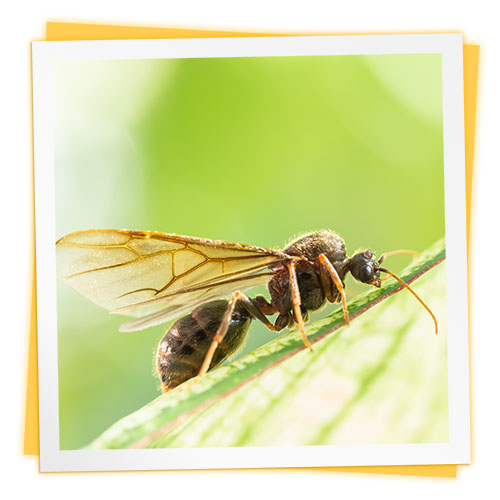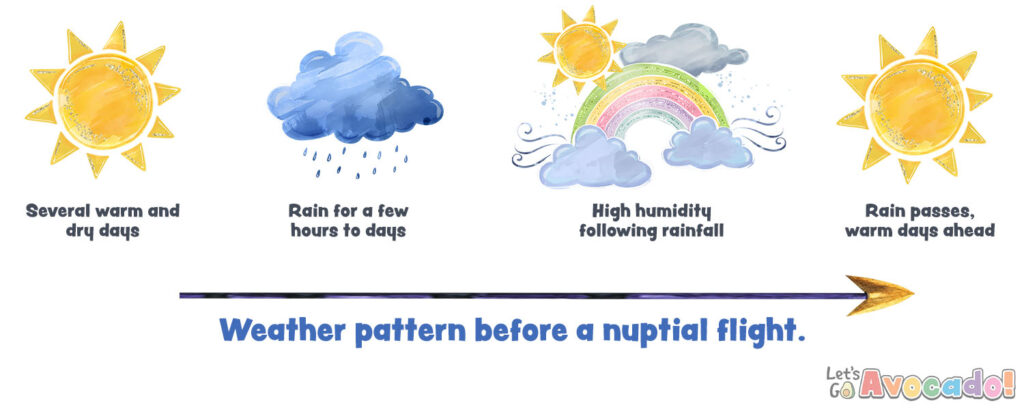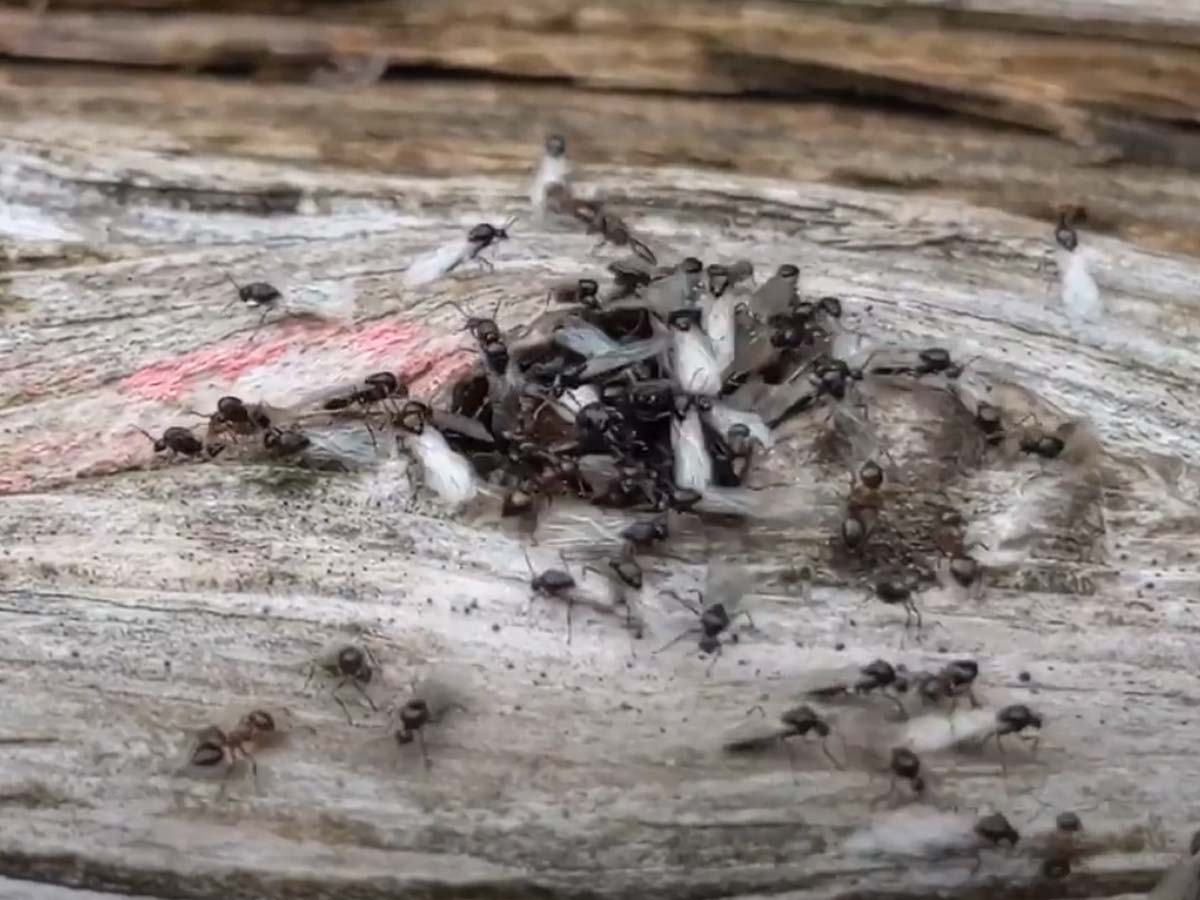This page may contain affiliate links.
Read our disclosure and privacy policy here.
Ant nuptial flights are an exciting time if you’re an ant-keeper! It a time when the alates of one or more species of ants take to the sky to mate and start the process of founding new colonies. When queen ants land on the ground after mating, they rip off their wings and start searching for a new colony site. At that moment, there will be dozens and dozens of queen ants wandering about on the ground. It’s the perfect time to select a queen ant to start your new colony. While some nuptial flights may happen unexpectedly, there are usually plenty of signs of an upcoming nuptial flight, if you know where to look and what to look for.
Table of Contents
3 Sure Signs of an Upcoming Nuptial Flight
The Nuptial Flight Of Individual Species
Nuptial flights will occur at different times for different species of ant, with some species having multiple nuptial flights within a range of 1 to 3 weeks. Keeping track of nuptial flights in your ant-keeping journal is a great way to help predict the general time frame for the nuptial flights of a specific species of ant. This information can be very helpful to you in future years, if you are trying to find a specific ant queen.
Knowing the general time frame of a nuptial flight is helpful, but there are other factors that can help narrow down the exact day that it may take place.

Did You Know?
Did You Know?
Download Printables
NUPTIAL FLIGHT SOCIETY
Ants are not the only insects to have nuptial flights. Termites and social bee species will also have nuptial flights to reproduce and start the next colony. Since all bees have wings, the reproductive members of their colony are not called alates. The term ‘alate’ is specifically used to distinguish the winged reproductive members of termite and ant colonies which reproduce through swarming, or nuptial flight. In some species of ant, nuptial flights do not take place. Instead, a future queen will simply walk to a new colony site with a line of drones (male ants) and workers in tow. These queens and drones are not called alates even though they may (or may not) have wings, because they mate within their colony instead of having a nuptial flight.

Sign 1: Favorable Weather Patterns for Nuptial Flights
Weather patterns can be great indicators of an upcoming nuptial flight. In general you would be looking for a few warm days with mid to low humidity, followed by several hours to a day of rainfall, followed by a warm to hot day with high humidity. It is on the warm, sunny, and humid day following a good rainfall that I have seen large numbers of nuptial flights in several parts of the city.
When considering how to predict nuptial flights, one of the key questions to ask is how exactly do ants know when it’s time? Ants from several neighboring colonies spread out over several kilometers need to make their nuptial flight at the same time. So how do they know when it’s time? How do these colonies coordinate?

It is not likely that there are messenger ants travelling between colonies letting everyone know when it’s time to go! But somehow, a message gets across to everyone. So who is the messenger? The weather! Temperature, humidity, wind, and rainfall all play an important role. And the weather is not going to be different within a space of a few kilometers. All ant colonies in an area get this message from nature at the same time.
If at least two neighboring ant colonies are tuned in to this messaging system, and act on the message at the same time, then their alates will find each other in the sky and mate successfully, guaranteeing that this specific interpretation of the weather patterns will survive into the next generation of ants. Those ant colonies which do not interpret the weather in the same manner as the others in their species, and in that particular area, will miss their nuptial flight.
In addition to the weather, there are other signs that you can use to predict an upcoming nuptial flight.
Sign 2: The Widening Of Colony Entrances
After a steady summer rainfall, wait a few hours after the rain has ended, and see if you can spot some newly created ant hills. The small mounds of fresh dirt that you see after rainfalls are the ants clearing out the debris that was washed into their colony during the rain.
These labor day ants (lasius neoniger) are widening the entrance to their colony prior to a nuptial flight.
Look closely – sometimes, they are doing more than this. You may see worker ants not only cleaning out their colony, but also widening the openings. Sometimes the openings may widen to 1cm or more in diameter – wide enough that you can see several worker ants milling about just inside the colony opening. Keep watching – you may see one or more winged ants, the alates of the colony, just inside the opening as well. At this point, they have not yet exited the colony, but they are preparing to do so. The workers are widening the opening to allow the alates to exit more easily and more quickly.
If you see this, you can bet that there is going to be a nuptial flight very soon, possibly later the same day, or the morning of the following day.
Sign 3: Alates Emerging From The Nest
When you start to see alates actually emerging from the nest, then you know that a nuptial flight is imminent, or already in progress. Alates are the most valuable resource in an ant colony, as they represent the future of the species. As such, they are heavily guarded.
If you turn over a rock and happen to find an ant colony where you can also see alates, watch for a moment. You’ll see the worker ants start to physically drag the alates back into the safety of the colony tunnels. They are trying to protect them as much as possible, sometimes even against the alate’s will! You’ll sometimes see the alate trying to go in one direction, but the worker ant is dragging it backwards back into the colony. This is an indication of how much a colony values it’s alates.
These acrobat ants alates (crematogaster cerasi) are emerging from their colony for their nuptial flight.
So alates don’t just emerge from a colony for some fresh air. If the workers allowed the alates to exit, it’s for one single reason: their nuptial flight. At this point, you can just sit back and watch as hundreds of alates walk around to try to find the highest point close to them, and then take off into the air.
Dinner Time!
If you do get lucky enough to actually witness a nuptial flight in progress, take a moment to look up and around you. You’ll likely find others have also gathered to witness this event. No – not other humans. Other animals! Bats, birds, and dragonflies may be swarming as well, looking to swoop down for an easy treat of fresh alates. Most alates are well fed by their colonies, and are a good source of protein for these flying predators.
In fact, between the predators in the air, and those on the ground like frogs, salamanders, snakes, spiders, mantises, and more, only a very few number of newly mated queens manage to successfully mate, land safely, and survive long enough to found a new colony. Some studies put the success rate at less than 2%. So out of every one hundred female alates that set off on their nuptial flight, only two extremely lucky ones will survive.
It’s a sad thought – but it’s also part of nature’s intricate balance.

DISCUSSION
DISCUSSION
DISCUSSION
FOLLOW-UP TOPICS
Science Topics
Social Insects
Observation

There’s a lot to explore right where we are, in our own neighborhoods and backyards! Join us while we get off the couch and explore the everyday wonders of nature, science, space, engineering, art, and anything else we stumble upon during on our adventures.



